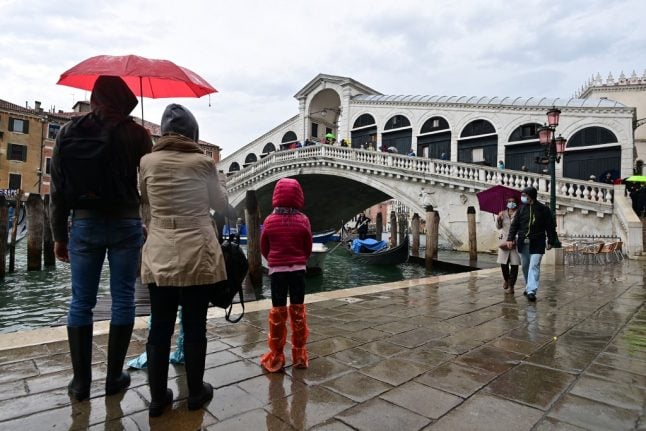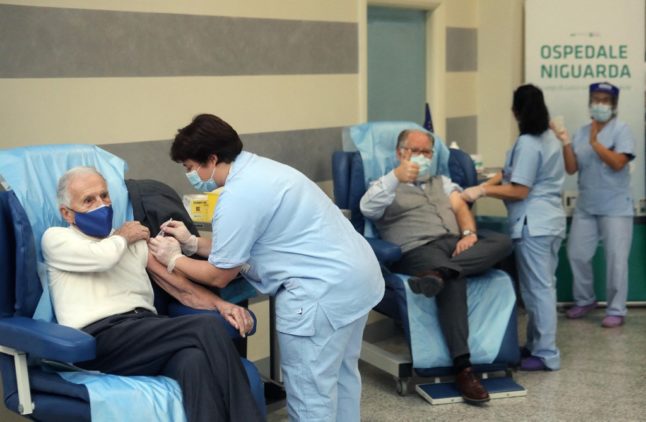Veneto, Emilia-Romagna and Friuli-Venezia Giulia will introduce new regional ordinances urging residents to avoid exercising or simply strolling on the streets of their town centres as part of efforts to avoid crowding and further transmission of the coronavirus.
READ ALSO: ‘No plan, just hope’: How is Italy going to get the second wave under control?
All three regions have opted to tighten local rules despite being classed as 'yellow zones', the lowest of three risk levels under the Italian government's tier system.
The added restrictions are the equivalent of “yellow plus”, said Veneto's regional governor Luca Zaia.
Speaking at a press conference on Thursday, he announced that the new rules would come into force from November 14th until December 3rd.
- No exercising or strolling in city centres, crowded areas or beachfronts;
- Bars and restaurants to become table service-only from 3 to 6pm;
- Weekly street markets are cancelled, unless they have a detailed safety plan in place;
- Shopping centres and outlets to close on weekends and all shops to close on Sundays, except for those selling essential supplies like supermarkets or pharmacies;
- Only one person per household will be allowed to enter a shop at a time, except for parents accompanying children or people who need assistance;
- Supermarkets are advised to reserve their first two hours of opening for shoppers aged over 65;
- In schools, sports lessons, singing and playing wind instruments are suspended.
Emilia-Romagna and Friuli-Venezia Giulia will apply similar restrictions at the same time, their governors said.
#CORONAVIRUS Nuova ordinanza regionale: dal 14 novembre, in Emilia-Romagna ulteriori misure restrittive per evitare assembramenti.
Leggi la notizia –> https://t.co/bo0uSrP2My
Ecco cosa cambia: pic.twitter.com/edVdD19efN— RegioneEmiliaRomagna (@RegioneER) November 12, 2020
Until the text of the new ordinances is published, it's unclear whether unauthorised strolling in one of the three regions will earn you a fine or simply a reprimand.
“We don't want to give fines, but shared rules that everyone respects,” said the governor of Friuli-Venezia Giulia, Massimiliano Fedriga.
Exercise is still allowed, but residents are urged to find an isolated area to go for a walk or run. Meanwhile they can still access city centres for a valid reason, such as to go to work, go shopping or visit a restaurant.
The new restrictions come on top of baseline national regulations that have already closed high schools, museums, cinema and theatres, set a curfew from 10pm and ordered bars and restaurants to close at 6pm.
Regions designated orange (medium-high risk) or red (high risk) have tougher limits in place, closing bars and restaurants to the public and banning travel between towns or outside the region.
The classification, which is based on a complex assessment of each region's epidemiological situation and the resilience of its health service, has proven controversial, with some of the regions currently reporting thousands of new infections per day – including Campania and Lazio – remaining yellow while regions with lower numbers are classed red or orange.
READ ALSO: How does Italy decide which regions are Covid-19 red zones?
The Health Ministry reevaluates the classification every few days, and it's rumoured that Veneto, Emilia-Romagna and Friuli-Venezia Giulia – as well as Campania – are all on its watchlist.
The three regions' joint ordinances are an effort to head off even tighter restrictions that could be ordered by the national government.
“It's better to make a few sacrifices today than find ourselves a red zone tomorrow,” said Zaia.



 Please whitelist us to continue reading.
Please whitelist us to continue reading.
Member comments